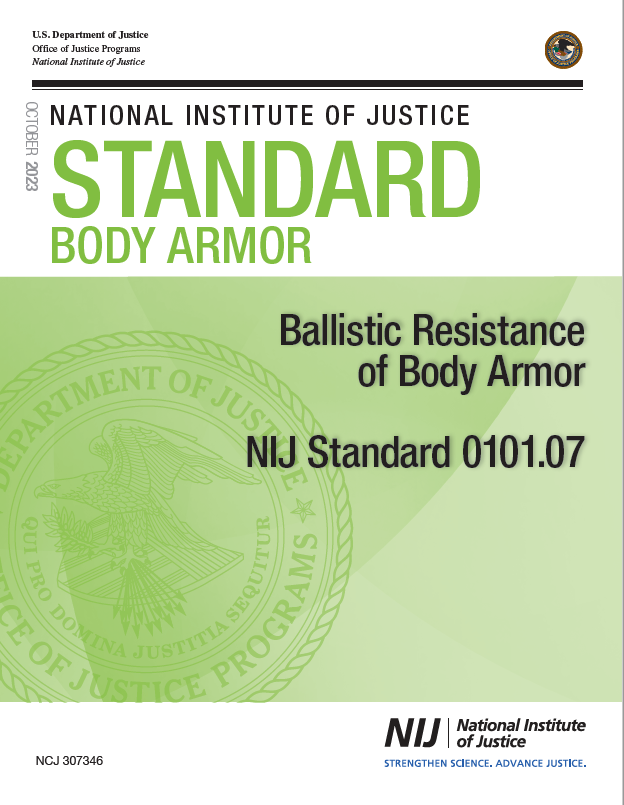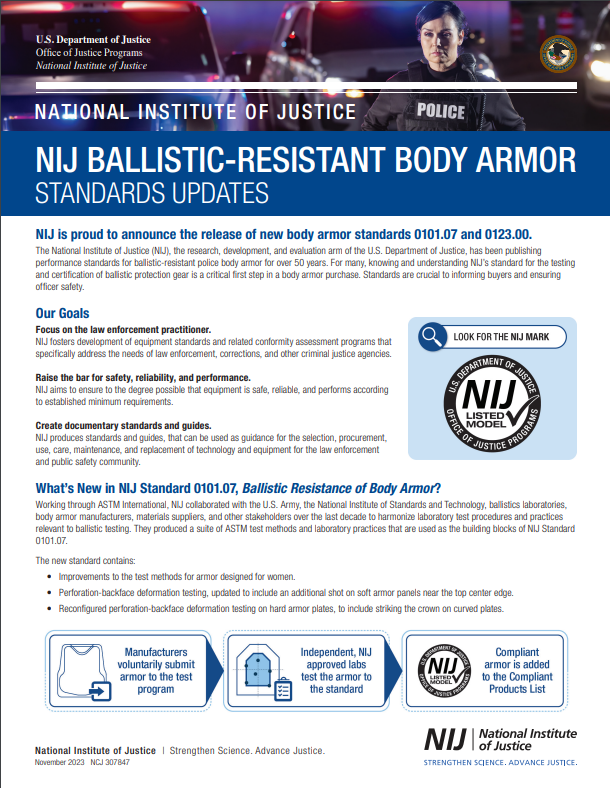NIJ’s planned online workshop for body armor manufacturers has been postponed from its original date of March 19, 2025. The webinar will provide updates on standards and conformity assessment activities related to ballistic-resistant body armor and include opportunities to ask questions. When a new date is determined, updated webinar information will be published here.
May 13, 2025: Removal of Ballistic Resistant Body Armor Models from Compliant Testing List and Program
The NIJ Compliance Testing Program (CTP) is taking action to remove armor models, listees, and individuals from further participation in the program in response to federal criminal enforcement actions. Read the full announcement.
NIJ has released three addenda to the standard. These addenda include revisions to NIJ Standard 0101.07, Ballistic Resistance of Body Armor. Users of NIJ Standard 0101.07 should incorporate the revisions in this addendum as a part of the NIJ Standard.
Addendum 1
- Addendum 1 showing changes in red and strikeout text.
- Addendum 1 showing changes in highlighted and strikeout text (this version is fully accessible to users with disabilities).
Addendum 2
- Addendum 2 showing changes in red and strikeout text.
- Addendum 2 showing changes in highlighted and strikeout text (this version is fully accessible to users with disabilities).
Addendum 3
- Addendum 3 showing changes in red and strikeout text.
- Addendum 3 showing changes in highlighted and strikeout text (this version is fully accessible to users with disabilities).
NIJ has been regularly engaging with ballistics laboratories since publication in November 2023 as they have put the new NIJ standards into practice, progressing through accreditation and research and development (R&D) testing of body armor. Questions regarding the new NIJ standards have also come from accreditors, body armor manufacturers, and ballistic material manufacturers. The addenda include several interpretations and clarifications regarding the content of NIJ Standard 0101.07 as a result of this stakeholder interaction.
NIJ plans to continue close coordination with ballistics laboratories and other stakeholders during the implementation phase of the new NIJ standards and anticipates publishing additional interpretations and clarifications going forward.
Most importantly, keep wearing the armor you have now. NIJ will continue to maintain its current list of armor that has already been certified to the previous standard for several years, so that manufacturers and agencies can transition to armor that meets the new standard. Given the large number of ballistic-resistant vests currently worn by law enforcement officers, the NIJ Compliance Testing Program anticipates maintaining the 0101.06 Compliant Products List through at least the end of calendar year 2027.
In early 2024, the NIJ Compliance Testing Program stopped accepting new armor models for testing under the old version of the standard. Behind the scenes, the National Voluntary Laboratory Accreditation Program (NVLAP) will use NIJ Standard 0101.07 to accredit ballistics laboratories and, in spring 2024, the program began testing, evaluation, and certification of ballistic-resistant body armor to the updated standard. Law enforcement agencies should expect to see body armor certified by NIJ to the 0101.07 standard sometime in late 2024 or early 2025.
This National Institute of Justice (NIJ) publication, Ballistic Resistance of Body Armor, NIJ Standard 0101.07, specifies minimum performance requirements and test methods for the ballistic resistance of body armor used by U.S. law enforcement that is intended to protect the torso against handgun and rifle ammunition. It is a revision of National Institute of Justice (NIJ) Standard 0101.06, Ballistic Resistance of Body Armor, published in 2008.[1]
The primary purpose of this standard will be for use by the NIJ Compliance Testing Program (CTP) for testing, evaluation, and certification of ballistic-resistant body armor. It will also be used by ballistic testing laboratories and body armor suppliers participating in the NIJ CTP. This standard will be included in the Law Enforcement and Corrections Equipment Laboratory Accreditation Program (LAP) of the National Voluntary Laboratory Accreditation Program (NVLAP) to accredit ballistics laboratories.[2]
NIJ Standard 0101.07 is divided into fourteen sections and eight appendices and differs from NIJ Standard 0101.06 in several important ways. Among these are notable structural changes between the two documents, as well as the introduction of several improvements to test methods and laboratory practices. An overview of these differences is provided in the following paragraphs.
Referencing a Suite of Standards
Unlike previous versions of the NIJ standard, NIJ Standard 0101.07 references a suite of standardized test methods and laboratory practices published by ASTM. NIJ, the U.S. Army, the National Institute of Standards and Technology (NIST), ballistics laboratories, body armor manufacturers, materials suppliers, and other stakeholders have been working collaboratively for several years within ASTM Committee E54 on Homeland Security Applications to harmonize, where possible, laboratory test procedures and practices relevant to ballistic testing. The result of this collaboration has been a suite of test methods and laboratory practices developed within ASTM Subcommittee E54.04 on Public Safety Equipment, many of which are referenced in this document.[3]
Incorporation of relevant ASTM standards into U.S. government standards and technical requirements affords the opportunity to harmonize laboratory test procedures and practices for both law enforcement and military ballistic-resistant armor and other ballistic-resistant equipment where the same general testing methodology otherwise applies. This also provides those end-user communities ultimate control over product specifications, such as the specific threats against which their equipment must protect.
Ballistic Threat Level Changes
The ballistic test threats are no longer listed in NIJ Standard 0101.07 as in past revisions of the standard. These have been moved into Specification for NIJ Ballistic Protection Levels and Associated Test Threats, NIJ Standard 0123.00, which is a new standalone document that defines ballistic threats identified by U.S. law enforcement as representative of current prevalent threats in the United States.
NIJ Standard 0123.00 was designed be used in conjunction with other standards like NIJ Standard 0101.07 to test and evaluate specific ballistic-resistant equipment, such as ballistic- resistant body armor, against contemporary ballistic threats that pose a life-threating safety hazard to U.S. law enforcement officers. The test projectiles and reference velocities in the inaugural version of NIJ Standard 0123.00 have been updated from section 2 of NIJ Standard 0101.06 to reflect the current threats faced by U.S. law enforcement end users, including a wider range of rifle threats.
Protection level nomenclature has also been moved into NIJ Standard 0123.00 and has been revised to be more descriptive of threats and to reduce confusion for users of body armor, see Table 1.
| Former Threat Level | New Threat Level | Notes |
|---|---|---|
| NIJ Level II | NIJ HG1 | HG = handgun |
| NIJ Level IIIA | NIJ HG2 | |
| NIJ Level III | NIJ RF1 | RF = rifle |
| NA | NIJ RF2 | NIJ RF2 is a new intermediate rifle protection level that includes all the threats at the NIJ RF1 protection level plus an additional threat |
| NIJ Level IV | NIJ RF3 |
NIJ Standard 0101.07 references the new ballistic protection levels in the inaugural version of NIJ Standard 0123.00 rather than defining the levels within NIJ Standard 0101.07 itself, as was done in NIJ Standard 0101.06 and previous versions.
Improved Test Methods for Armor Designed for Women
Fourth, this standard contains improvements to the test methods for armor designed for women, including new clay appliques (e.g., build-up of clay) to ensure better contact of nonplanar panels with the clay backing material and new shot requirements to assess shaping features. Shot placement has also been reconfigured to exploit potential vulnerabilities due to unique construction elements in the panel and nonzero angles of incidence in the proximity of edges.
Earlier drafts of NIJ Standard 0101.07 initially referenced ASTM E3086, Standard Practice for Creating Appliques for Use in Testing of Nonplanar Soft Body Armor Designed for Females.
This ASTM standard specified a procedure for creating appliques for use behind nonplanar soft armor panels and affixing the appliques to the clay block. The purpose was to specify critical parameters for creating appliques in order to improve consistency of the test setup between laboratories. The practice described a single applique shape applicable only to nonplanar, soft body armor designed for women.
Implementation of this laboratory practice proved more challenging than expected, including difficulty creating the specific applique shapes described in ASTM E3086 and ensuring proper contact with the armor panel once mounted on the clay block. These challenges required reconsideration of how to build up clay behind nonplanar soft armor panels. A more simplified applique was developed to ensure that the panels are fully filled in with clay before mounting on the clay block. This applique is more monolithic in form and better supports armors designed for female wearers during testing. It is created using one of two standardized mold sizes along with a procedure to shape its form once affixed to the clay block. The result is a better substrate to ballistically test nonplanar armor, replacing the procedure in ASTM E3086. The electronic files containing the drawings of the molds to make the clay appliques described in Appendix G are freely available to NIJ-approved testing laboratories and other organizations upon request.
Updated Perforation-Backface Deformation Testing
NIJ has updated perforation-backface deformation (P-BFD) testing to include an additional shot on soft armor panels. How soft armor responds to handgun projectiles striking very near the top edge of a front armor panel has been explored by an adjacent U.S. Government agency through experimental testing efforts. This involved mounting a ballistic vest with soft armor panels in an external carrier onto a model female torso made of molded ballistic gelatin. In this configuration, the top of the panel is naturally slanted back toward the torso in the carrier, creating an angle of obliquity between the armor panel and the trajectory of the incoming bullet. Shots striking the top-center edge at angles of obliquity in excess of approximately 40° have been demonstrated in some exploratory tests to not fully engage all layers of the armor panel and deflect off a middle layer into the neck region of the gelatin torso.
For soft armor, NIJ has added a shot located at the top center at the minimum shot-to-edge distances (2 in. or 3 in.) for the respective NIJ HG1 and NIJ HG2 threats at a 45° angle of obliquity between the shot and the armor test item. This added shot applies to all soft armor tested, both planar and nonplanar.
- For planar soft armor, the clay block is rotated a 45° angle of incidence to introduce the obliquity for the shot striking the armor.
- For nonplanar soft armor, the built-up clay of the applique introduces an approximately 15° angle of obliquity by slanting the top of the armor panel back toward the clay block. The clay block is rotated an additional 30° angle of incidence to yield the required 45° obliquity for the shot striking the armor.
This new shot will provide minimum performance for soft armor for handgun projectiles striking that location.
NIJ has also reconfigured P-BFD testing on hard armor plates to include striking the crown on curved plates. The crown is defined as the location of the highest point of the strike face of the plate when the plate is lying horizontally on a flat surface, at the intersection of multiple different curvatures. The placement of a shot on the crown probes the performance of hard armor in a location that may be more vulnerable to penetration due to characteristics of the materials or construction methods used to manufacture plates. This shot location is consistent with testing conducted by the U.S. Army on hard armor to meet its specifications, bringing the NIJ standard into better alignment with U.S. Army testing of hard armor plates.
A previous draft of this standard was published for public comment in the Federal Register.[4]
NIJ released addendum 1 for this standard. Access the addendum.
NIJ released addendum 2 for this standard. Access the addendum.
NIJ released addendum 3 for this standard. Access the addendum.



